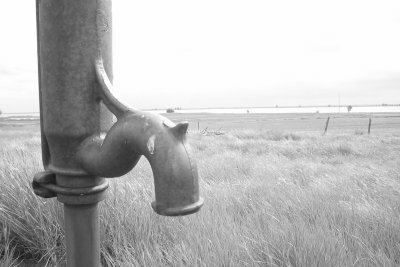Install the hand pump in the garden
Hand pumps in the garden have the advantage that you can move water at any time regardless of electricity. Since there are different hand pumps, there are a few things to consider.

What you need:
- Hand pump
- Sealing hemp
- cables
- Pump stick
Hand pumps for gardens
There are very different hand pumps that can be used for gardens. Not every pump is suitable for every purpose.
- Vane pumps are operated with a hand lever that is swiveled from right to left and back. Inside there are wings that are equipped with flaps. These open and close depending on the direction of rotation and suck in water, convey it into the pump room and from there into a pressure line. These pumps can build up water pressure and so water can also be sprayed with them.
- Similar to vane pumps, diaphragm pumps build up a negative pressure through which suction takes place. But the water is separated from the mechanics by an elastic wall (membrane). This protects it from contamination by sand and mud in the water and the water does not come into contact with substances that are present in the mechanics of the pump. Diaphragm pumps can also build up pressure. The operation is comparable to a vane pump.
- Stroke piston pumps work via a piston that is moved vertically in a pipe and are so-called positive displacement pumps. The best known type of these hand pumps are handle pumps for the garden. When you push the handle (handle) down, the piston moves upwards and water flows through an inlet valve into the pump chamber. When the handle is lifted, it closes the inlet valve and the water from the pump chamber is pushed through the outlet of the pump. There is no water pressure.
Installation of hand operated garden pumps
Hand pumps such as vane pumps or diaphragm pumps are often not permanently installed. If necessary, a hose line is placed in the water that is to be pumped and the pump is held in the hand or screwed onto a pole and the water is pumped in this way. This is different with handle pumps:
Bring the handle pump over the winter - this is how you do it right
A handle pump enriches every garden. It is not only beautiful to look at, ...
- Handle pumps are permanently installed because they need a good stand. For this reason, it is imperative to create a solid base for these pumps. It is best to pour a concrete slab at the extraction point.
- Depending on the type of well, you can simply insert a suction line into an existing well or cistern place, or the hand pump at the end of a rod of a piling well with a pump stick attach.
- Pay attention to the maximum suction height that your pump can handle and that the suction pipe ends reliably below the surface of the water, but not in the silt.
- Seal all connections with hemp and sealing paste, but never use sealing tape to seal the line to your hand pump.
- If you have just driven the ramming well into the ground, first connect a fresh water line to flush the well. Only then do you connect the pump block and the hand pump to the thread of this pipeline. At the beginning, remove only a little water at a time so that the filter does not clog. Don't forget to pour water on the pump, i.e. fill the pump chamber with water so that the pumping works.
- The pump must be emptied before the frost so that it is not damaged. If you have a manhole well, you can also install a frost-proof pump. In this case, the pumping work takes place approx. 3m below the surface of the earth. A long rod operates the hand pump device at this depth.
- With handle pumps, make sure that they are firmly mounted on the concrete slab and that the pump frame is not tilted when it is connected to the suction power.
How helpful do you find this article?


